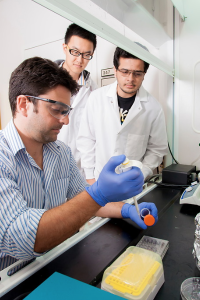Document Type
Article
Publication Title
Molecular and Cellular Biology
Abstract
Spinocerebellar ataxia type 10 (SCA10) is associated with expansion of (ATTCT)n repeats (where n is the number of repeats) within the ataxin 10 (ATX10/E46L) gene. The demonstration that (ATTCT)n tracts can act as DNA unwinding elements (DUEs) in vitro has suggested that aberrant replication origin activity occurs at expanded (ATTCT)n tracts and may lead to their instability. Here, we confirm these predictions. The wild-type ATX10 locus displays inefficient origin activity, but origin activity is elevated at the expanded ATX10 loci in patient-derived cells. To test whether (ATTCT)n tracts can potentiate origin activity, cell lines were constructed that contain ectopic copies of the c-myc replicator in which the essential DUE was replaced by ATX10 DUEs with (ATTCT)n. ATX10 DUEs containing (ATTCT)27 or (ATTCT)48 but not (ATTCT) 8 or (ATTCT)13, could substitute functionally for the c-myc DUE, but (ATTCT)48 could not act as an autonomous replicator. Significantly, chimeric c-myc replicators containing ATX10 DUEs displayed length-dependent (ATTCT)n instability. By 250 population doublings, dramatic two- and fourfold length expansions were observed for (ATTCT) 27 and (ATTCT)48 but not for (ATTCT)8 or (ATTCT)13. These results implicate replication origin activity as one molecular mechanism associated with the instability of (ATTCT)n tracts that are longer than normal length. Copyright © 2007, American Society for Microbiology. All Rights Reserved.
First Page
7828
Last Page
7838
DOI
10.1128/MCB.01276-07
Publication Date
11-2011
Recommended Citation
Liu, G., Bissler, J.J., Sinden, R.R., Leffak, M. Unstable spinocerebellar ataxia type 10 (ATTCT)·(AGAAT) repeats are associated with aberrant replication at the ATX10 locus and replication origin-dependent expansion at an ectopic site in human cells (2007) Molecular and Cellular Biology, 27 (22), pp. 7828-7838.


